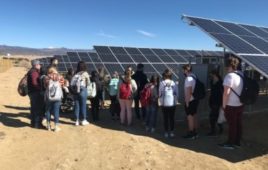The utilization of renewable energy sources has become increasingly imperative in modern education systems. A remarkable example can be found at a school in Colorado, where the integration of a cutting-edge 500-kW solar array has revolutionized their science curriculum. This innovative initiative not only provides students with hands-on experience but also fosters an understanding of sustainable practices and environmental stewardship.
A Revolutionary Approach to Science Education
By incorporating a state-of-the-art 500-kW solar array into their science curriculum, this Colorado school is taking an unprecedented approach to teaching scientific concepts. Students now have the opportunity to engage directly with renewable energy technologies, allowing them to witness firsthand how solar power can be harnessed and utilized as an alternative source of electricity.
This immersive learning experience goes beyond traditional classroom instruction by providing students with practical knowledge that they can apply outside the confines of academia. As they explore the inner workings of the solar array, students gain valuable insights into topics such as photovoltaic technology, energy conversion processes, and sustainability principles.
Fostering Environmental Consciousness
In addition to enhancing scientific literacy, this integration serves as a catalyst for fostering environmental consciousness among students. By actively participating in projects related to clean energy generation, young minds are sensitized towards pressing global issues like climate change and resource depletion.
Through engaging discussions on topics such as carbon footprints and greenhouse gas emissions reduction strategies facilitated by this groundbreaking initiative, learners develop critical thinking skills necessary for addressing complex ecological challenges faced by our planet today.
An Investment in Future Generations
The implementation of this 500-kW solar array underscores the commitment made by educational institutions towards equipping future generations with essential tools needed to navigate an increasingly sustainable world. By providing students with a comprehensive understanding of renewable energy systems, this Colorado school is empowering them to become agents of change in their communities.
Furthermore, the integration of such advanced technologies into the curriculum not only prepares students for careers in science and engineering but also instills a sense of responsibility towards preserving our planet’s natural resources.
Conclusion
The incorporation of a 500-kW solar array into the science curriculum at this Colorado school represents a paradigm shift in education. Through hands-on experiences and immersive learning opportunities, students are equipped with both theoretical knowledge and practical skills necessary for addressing pressing environmental challenges. This innovative approach not only enhances scientific literacy but also cultivates an environmentally conscious mindset among future leaders, ensuring a brighter and more sustainable future for all.






